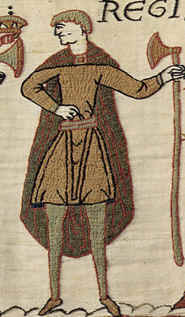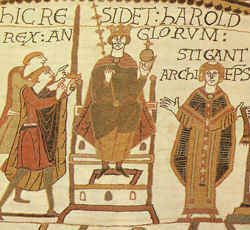Harold of Wessex, as king of England, led the English army into battle against William the Conqueror in 1066 at the Battle of Hastings. Harold was killed in this battle which was fought to establish who should be king after the death of Edward the Confessor.
|
Harold of Wessex |
Harold was born in about 1022. His father, Godwin of Wessex, was the most powerful nobleman in England. Harold became Earl of East Anglia in 1046. He also got a share of his brother Swegen’s lands when Swegen was sent into exile in 1046. When Godwin was exiled in 1051, Harold went to Ireland where he stayed with the Dermont, King of Leinster. In 1052, when his father returned to England, Harold did the same. Godwin regained all that he has lost when he had been sent into exile. In 1053, Godwin died and Harold succeeded his father as Earl of Wessex. From this time on Harold was a loyal supporter of Edward the Confessor.
In 1063, Harold led an English army into Wales – an area that had never been overly respectful of English power. Reports from the time indicate that his army killed every adult Welsh male they came across. His campaign of terror left parts of Wales depopulated.
When he was not away campaigning, Harold found time to get married. He married Eadgyth Swanneck and they had five children. He also wanted to create a place of learning which is why he funded the creation of a large church in Waltham which had a chancellor, a dean and twelve canons. The chancellor, Adelard of Liege, was famed for his lectures.
In 1064, Harold was shipwrecked on the coast of Ponthieu. William of Normandy
ordered the Duke of Ponthieu, Guy, to hand over Harold. Harold went to Rouen with William and accompanied William into battle. It was after one such battle against Conan of Brittany, that Harold is said to have promised William that he would support William’s claim to the throne of England on the death of Edward. With this ‘promise’, William allowed Harold to return to England. When Harold returned to England, he claimed that the ‘promise’ had been forced out of him. If he had not made it, he would have spent the rest of his life as a captive in Normandy. Therefore, Harold concluded, any such ‘promise’ had no legal backing.
Edward died on January 5th 1066. On January 6th, the Witan met to decide who should succeed Edward as he left no heir to the throne of England. The Witan consisted of 60 of England’s most powerful nobles and they decided that Harold should be the new king of England. There is a popular belief that Harold somehow seized the English throne. In fact, it was offered to him by the Witan. The Witan had discussed the merits of other candidates: William of Normandy, Harold Hardrada of Norway and Edgar Etheling. Out of the four, Harold was chosen.
|
Harold crowned as king of England |
After his coronation, Harold did expect some form of reaction from William. Harold placed a large number of troops along the south coast to the Isle of Wight. By September, Harold decided that the threat had been reduced and he allowed his part-time troops (the fyrds) to disperse. Many were needed for harvesting.
However, Harold then had to cope with an attack by his brother Tostig and the king of Norway, Harold Hadrada. Tostig had invaded in the north of England and Harold had to move his army north with due speed. They fought at the Battle of Stamford Bridge on September 24th 1066. Harold won; Tostig and Hadrada were killed.
William and his forces landed at Pevensey Bay. Harold was still in the north of England. Marching south, Harold rejected the thoughts of his brother Gyrth, who wanted to lead the English in battle as Gyrth felt that Harold, as king of England, was putting himself at risk.
Harold was killed at the Battle of Hastings on October 15th. The Bayeaux Tapestry shows him getting an arrow in the eye. In truth, we will never know how Harold died but it is highly unlikely that a king of England would have been on foot armed with a spear – as the tapestry shows.
After the battle finished, Harold’s mother, Gytha, asked William to return Harold’s body to her for a proper burial. She offered William Harold’s weight in gold. William refused. He was convinced that Harold had broken a sacred oath and that, even in death, he should pay for that. Harold’s body, so it is said, was buried on the beach at Pevensey Bay, on the shores he had tried to defend. By doing this, William ensured that Harold was not buried in a Christian manner. Some believe that his body was finally buried at the church he had established at Waltham.
Related Posts
- 1066 is considered one of those dates in Medieval England which is difficult to forget. At the start of 1066, England was ruled by Edward…

